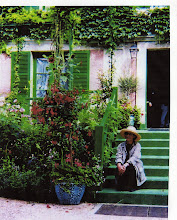Monday, May 18, 2009
Oh those invasives
Wednesday, May 6, 2009
New York Times January 5, 2009
A 50-Year Farm Bill
THE extraordinary rainstorms last June caused catastrophic soil erosion in the grain lands of Iowa, where there were gullies 200 feet wide. But even worse damage is done over the long term under normal rainfall — by the little rills and sheets of erosion on incompletely covered or denuded cropland, and by various degradations resulting from industrial procedures and technologies alien to both agriculture and nature.
Soil that is used and abused in this way is as nonrenewable as (and far more valuable than) oil. Unlike oil, it has no technological substitute — and no powerful friends in the halls of government.
Agriculture has too often involved an insupportable abuse and waste of soil, ever since the first farmers took away the soil-saving cover and roots of perennial plants. Civilizations have destroyed themselves by destroying their farmland. This irremediable loss, never enough noticed, has been made worse by the huge monocultures and continuous soil-exposure of the agriculture we now practice.
To the problem of soil loss, the industrialization of agriculture has added pollution by toxic chemicals, now universally present in our farmlands and streams. Some of this toxicity is associated with the widely acclaimed method of minimum tillage. We should not poison our soils to save them.
Industrial agricultural has made our food supply entirely dependent on fossil fuels and, by substituting technological “solutions” for human work and care, has virtually destroyed the cultures of husbandry (imperfect as they may have been) once indigenous to family farms and farming neighborhoods.
Clearly, our present ways of agriculture are not sustainable, and so our food supply is not sustainable. We must restore ecological health to our agricultural landscapes, as well as economic and cultural stability to our rural communities.
For 50 or 60 years, we have let ourselves believe that as long as we have money we will have food. That is a mistake. If we continue our offenses against the land and the labor by which we are fed, the food supply will decline, and we will have a problem far more complex than the failure of our paper economy. The government will bring forth no food by providing hundreds of billons of dollars to the agribusiness corporations.
Any restorations will require, above all else, a substantial increase in the acreages of perennial plants. The most immediately practicable way of doing this is to go back to crop rotations that include hay, pasture and grazing animals.
But a more radical response is necessary if we are to keep eating and preserve our land at the same time. In fact, research in Canada, Australia, China and the United States over the last 30 years suggests that perennialization of the major grain crops like wheat, rice, sorghum and sunflowers can be developed in the foreseeable future. By increasing the use of mixtures of grain-bearing perennials, we can better protect the soil and substantially reduce greenhouse gases, fossil-fuel use and toxic pollution.
Carbon sequestration would increase, and the husbandry of water and soil nutrients would become much more efficient. And with an increase in the use of perennial plants and grazing animals would come more employment opportunities in agriculture — provided, of course, that farmers would be paid justly for their work and their goods.
Thoughtful farmers and consumers everywhere are already making many necessary changes in the production and marketing of food. But we also need a national agricultural policy that is based upon ecological principles. We need a 50-year farm bill that addresses forthrightly the problems of soil loss and degradation, toxic pollution, fossil-fuel dependency and the destruction of rural communities.
This is a political issue, certainly, but it far transcends the farm politics we are used to. It is an issue as close to every one of us as our own stomachs.
Wes Jackson is a plant geneticist and president of The Land Institute in Salina, Kan. Wendell Berry is a farmer and writer in Port Royal, Ky.
Monday, May 4, 2009
Spring progresses


Next week the "Bridesmaids" bloom - flowering Crabapples I brought bare root across country one freezing February in my moving truck. It is my favorite week to be here - and I will be on the road collecting plants for clients - last weeks heat wave is pushing my schedule.
Shad!



 Ah, true spring comes to Nantucket - the Shad have bloomed. And I'm sure the Herring are running at the Massasoit bridge, Night Herons standing guard like Egyptian paintings and Gulls circling.
Ah, true spring comes to Nantucket - the Shad have bloomed. And I'm sure the Herring are running at the Massasoit bridge, Night Herons standing guard like Egyptian paintings and Gulls circling.
